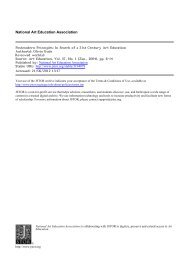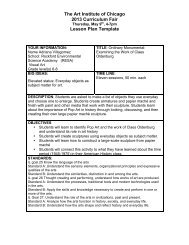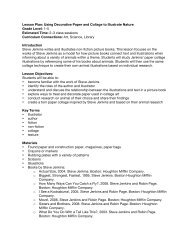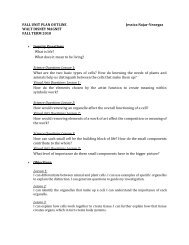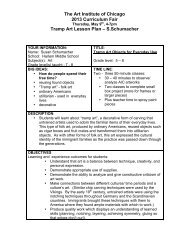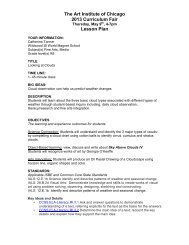Lesson 1 - LearningThroughMuseums
Lesson 1 - LearningThroughMuseums
Lesson 1 - LearningThroughMuseums
Create successful ePaper yourself
Turn your PDF publications into a flip-book with our unique Google optimized e-Paper software.
● Advance Preparation<br />
• Prepare to display the reproduction of Harvest Talk in the classroom for student viewing.<br />
• Review the Background Information section of this lesson about Harvest Talk.<br />
● Vocabulary<br />
compare<br />
culture<br />
diversity<br />
evidence<br />
scythe<br />
● Procedure<br />
1. Provide background information about Harvest Talk that you think is relevant for the students<br />
to interpret it. Include the information about the context—that it shows two workers<br />
sharpening a scythe, or curved blade, which they use to cut the tall grasses in the field at<br />
harvest time. Explain to them that this was painted during a time in America when African<br />
Americans were fighting for their civil rights and facing discrimination.<br />
2. Ask students what they think the two workmen might have said to one another, or what their<br />
talk might have been about.<br />
3. Ask students to use the Inferring Values organizer to identify values represented by Harvest<br />
Talk.<br />
4. Then discuss with the students the values they inferred. Accept any values that students<br />
identify with evidence, and emphasize that an artwork can communicate different values to<br />
different people.<br />
5. If the students do not suggest it, then explain that this artwork also is about the dignity of work.<br />
Tell students that the dignity of work was the main idea that Charles White wanted to<br />
communicate through the artwork. Ask them to identify evidence of that value in the work.<br />
6. Explain that you are pointing out the dignity of work as a value to show that some values are<br />
shared by different cultures since they saw the same value in The Weaver.<br />
Days 3–4: Core Values<br />
● Time Allotment<br />
two days, 45 minutes each day (or two, 45-minute segments on one day)<br />
● Materials<br />
• Reproduction of The Child’s Bath, 1893<br />
Materials for each student:<br />
Copy of Inferring Values organizer (optional)<br />
Copy of Picturing Values organizer<br />
Copy of Writing to Communicate Values organizer<br />
Colored Pencils (optional for Picture Values organizer)<br />
Art Institute of Chicago • 99



